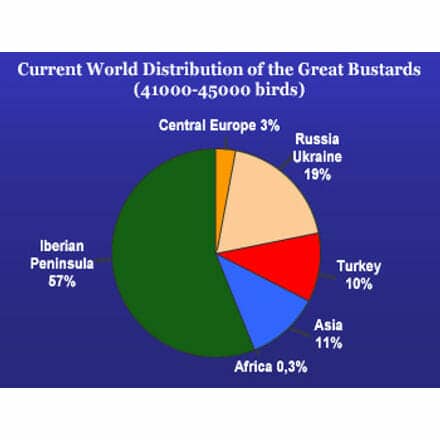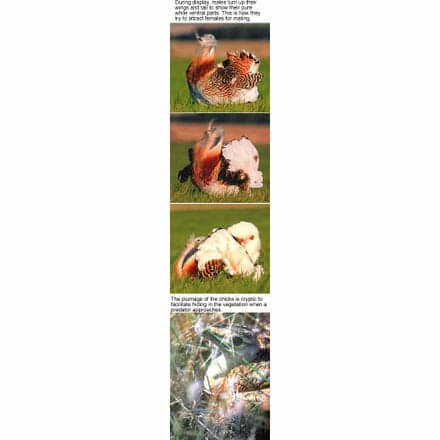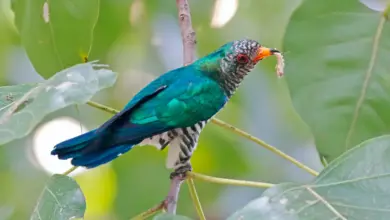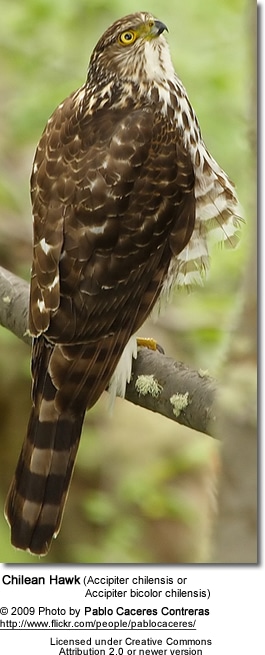Great Bustards (Otis tarda)
The Great Bustards, Otis tarda, is in the bustard family, the only member of the genus Otis. Within its natural range, it is the largest species of bird.
Distribution / Habitat
The Great Bustard is endemic to southern and central Europe, where it is the largest species of bird, and across temperate Asia. European populations are mainly resident, but Asian birds move further south in winter. Populations exist in Hungary, Portugal, Slovakia, Russia and Spain.
The Great Bustard inhabits open, flat or slightly undulating, usually treeless cereal farmland.

It belongs to a quite homogeneous bird family, the Otididae, which also includes two other species in Europe, the Little Bustard (Tetrax tetrax), widespread over the Iberian Peninsula, and the Houbara Bustard (Chlamydotis undulata), in the Canary Islands. Both are much smaller than Great Bustard.
The family Otididae, which currently includes 25 species, originated some 50 million years ago in Africa. Twenty-one of these species still survive in the African continent.
Bustards inhabit dry or semiarid areas of temperate to tropical latitudes of all continents, with the exception of America and Antarctica.
Description
The Great Bustards (Otis tarda) stands out of the “bird crowd” as far as weight is concerned. The males of this species can weigh up to 46 pounds (20.9 kg).
Males (left) may weigh up to 20.5 kg (46 pounds), while females (right) rarely exceed 4-5 kg and have a more slender silhouette and more cryptic plumage.
Great Bustards have one of the highest sexual size dimorphism among Vertebrates. During most parts of the year both sexes live in separate flocks. This is just one of the consequences of the strong sexual size dimorphism, which determines marked sex differences not only in food requirements, but also in their breeding, dispersal and migratory behaviour.
Males (left) develop in spring a colourful breeding plumage that they exhibit during sexual display in front of other flock-mates and females. Tufts of modified feathers, the so-called moustachial feathers, grow at each side of the beak. Each year these feathers grow longer, reaching over 20 cm in old males.
Females (right) tend to flock with genetically related individuals. They are more gregarious and philopatric than males, remaining frequently at their natal areas throughout their entire lives.
As could be expected from the strong sexual size dimorphism, the sex ratio is naturally skewed toward females, so that the latter can easily double males in number. The sexual selection pressures acting upon males are the cause of their higher natural mortality, as well as their higher vulnerability to human-induced threats.
During display, males turn up their wings and tail to show their pure white ventral parts. This is how they try to attract females for mating.
Sexual dimorphism (visual physical differences between the sexes) in size is also related to the strong sexual selection and polygyny that are characteristic of this species. All males of the breeding group gather at traditional display arenas, termed leks (competitive mating displays or dancing grounds), where they fight in winter and early spring for a higher position in the flock hierarchy.
In spring, all adult males of the flock display at the lek site to attract females. Only the best males of the group will succeed in mating, and some of them will copulate with several females.
Females visit the display arena and choose their mates among displaying males. Incubation and chick rearing is exclusively performed by females.
Nesting / Breeding
Nests are shallow scrapes in the ground partly covered with some dry vegetation. Females lay one to three greenish, brown spotted eggs.
The chicks hatch from late May onwards, after four weeks incubation. Although most females older than two years attempt to breed every year, on average only 10-12% will rear a chick per season. The offspring have a prolonged maternal care period of six to over twelve months.
The plumage of the chicks is cryptic to facilitate hiding in the vegetation when a predator approaches.
Current World Distribution
The world Great Bustards population can be estimated at present around 45000 birds. The Iberian Peninsula, with over 50% of the world population, probably represents the last stronghold of the species in the world. All other populations surviving at present are much smaller, many have suffered dramatic decreases, and some are now threatened with extinction.
The species is considered globally threatened, and in Spain it is classified as vulnerable. This means that the survival of Spanish populations might be endangered by human-induced changes in the habitat, catastrophic events, or any other causes which might affect their population dynamics.
Population Trends
The graph shows the estimated effect of hunting during the last four decades in Spain. A marked decline in Great Bustard numbers probably occurred due to high hunting pressure immediately before the hunting ban in 1980 when, according to reports from the hunter E. Trigo de Yarto, official hunting bags reached over 2000 birds annually.
We suggest that the hunting prohibition has allowed a recovery of many populations, some of which are even slightly increasing today.

However, these increases are compensated by declines at other areas. Thus we believe that the overall population has remained more or less stable at around 23000 birds over the last two decades.
Most central European populations have suffered dramatic decreases during the 20th century due to hunting and agricultural intensification. In many countries the species went extinct, whereas in others the small groups that survive are seriously endangered.
In Russia and Turkey Great Bustards numbers are still relatively high, although their conservation status is much less secure than in Iberia. In Morocco, the only African country where the species is present, it is severely endangered by hunting and other human pressures. In Asia the population is vulnerable, with less than 5000 birds.
Source: Great Bustard Project






